
eBook - ePub
Wildlife Sketching
Pen, Pencil, Crayon and Charcoal
Frank J. Lohan
This is a test
Buch teilen
- 256 Seiten
- English
- ePUB (handyfreundlich)
- Über iOS und Android verfügbar
eBook - ePub
Wildlife Sketching
Pen, Pencil, Crayon and Charcoal
Frank J. Lohan
Angaben zum Buch
Buchvorschau
Inhaltsverzeichnis
Quellenangaben
Über dieses Buch
For every artist who longs to capture the beauty of nature on paper, here is clear, concise instruction on creating true-to-life drawings. Author Frank Lohan, an experienced teacher, stresses perceptive study and analysis. His numerous examples illustrate how to discover the underlying geometric shapes of natural subjects, and they show how to develop sketches that form the basis of realistic compositions.
Beginning and advanced artists as well as wildlife enthusiasts will appreciate these 600 images of birds, flowers, trees, animals, reptiles, and amphibians. Step-by-step methods, explained in simple terms, offer guidance on selecting tools and materials; creating perspective drawings; employing pencil, pen, and charcoal techniques; and other approaches.
Beginning and advanced artists as well as wildlife enthusiasts will appreciate these 600 images of birds, flowers, trees, animals, reptiles, and amphibians. Step-by-step methods, explained in simple terms, offer guidance on selecting tools and materials; creating perspective drawings; employing pencil, pen, and charcoal techniques; and other approaches.
Häufig gestellte Fragen
Wie kann ich mein Abo kündigen?
Gehe einfach zum Kontobereich in den Einstellungen und klicke auf „Abo kündigen“ – ganz einfach. Nachdem du gekündigt hast, bleibt deine Mitgliedschaft für den verbleibenden Abozeitraum, den du bereits bezahlt hast, aktiv. Mehr Informationen hier.
(Wie) Kann ich Bücher herunterladen?
Derzeit stehen all unsere auf Mobilgeräte reagierenden ePub-Bücher zum Download über die App zur Verfügung. Die meisten unserer PDFs stehen ebenfalls zum Download bereit; wir arbeiten daran, auch die übrigen PDFs zum Download anzubieten, bei denen dies aktuell noch nicht möglich ist. Weitere Informationen hier.
Welcher Unterschied besteht bei den Preisen zwischen den Aboplänen?
Mit beiden Aboplänen erhältst du vollen Zugang zur Bibliothek und allen Funktionen von Perlego. Die einzigen Unterschiede bestehen im Preis und dem Abozeitraum: Mit dem Jahresabo sparst du auf 12 Monate gerechnet im Vergleich zum Monatsabo rund 30 %.
Was ist Perlego?
Wir sind ein Online-Abodienst für Lehrbücher, bei dem du für weniger als den Preis eines einzelnen Buches pro Monat Zugang zu einer ganzen Online-Bibliothek erhältst. Mit über 1 Million Büchern zu über 1.000 verschiedenen Themen haben wir bestimmt alles, was du brauchst! Weitere Informationen hier.
Unterstützt Perlego Text-zu-Sprache?
Achte auf das Symbol zum Vorlesen in deinem nächsten Buch, um zu sehen, ob du es dir auch anhören kannst. Bei diesem Tool wird dir Text laut vorgelesen, wobei der Text beim Vorlesen auch grafisch hervorgehoben wird. Du kannst das Vorlesen jederzeit anhalten, beschleunigen und verlangsamen. Weitere Informationen hier.
Ist Wildlife Sketching als Online-PDF/ePub verfügbar?
Ja, du hast Zugang zu Wildlife Sketching von Frank J. Lohan im PDF- und/oder ePub-Format sowie zu anderen beliebten Büchern aus Art & Art Techniques. Aus unserem Katalog stehen dir über 1 Million Bücher zur Verfügung.
Information
Thema
ArtThema
Art Techniques1
Tools and Materials
Pencil Drawing
Pen Drawing
Paper
Pencil Drawing
The tools needed for pencil. drawing are inexpensive and readily available in any art supply store. Pencils, two kinds of erasers, an erasing shield, paper towel, and fixative to eliminate smudging are all you need for many hours of drawing.
Pencils
There are dozens of kinds of pencils available for sketching. The pencil illustrations in this book were done using only graphite pencils in hardness grades 2H, HB, 3B, and 6B (fig. 1-1). The H series is hard, while the B series is soft. The larger the H number, the harder the lead is. The larger the B number, the softer the lead is. Using a 6H pencil can be like drawing with a nail—it makes a light line and usually leaves an indentation in the paper.
I do not recommend the common No. 2 writing pencil as there is no telling just how hard or soft any brand might be. It is best to buy four drawing pencils, all from the same brand, in the 2H, HB, 3B, and 6B grades. This will give you a completely adequate tonal range for the subjects treated in this book.
Sharpen your pencils with a pen knife or single-edge razor blade or a utility knife. Leave about one-quarter inch of lead beyond the wood (fig.1-3). Then, using a small piece of sandpaper (fig. 1-2), put a slanted, flat surface on the lead. This gives you a broad, flat surface so that you can cover larger areas with a uniform tone, and also gives you a very sharp edge at the tip for putting details in place. I glue a small piece of sandpaper in the cover of a small box, and also glue a piece of paper towel there. This keeps the graphite dust in the box and off my drawing, and gives me a towel to wipe the lead on each time I sharpen it.
Erasers
I recommend two different erasers: one is a soft, pink or white pencil eraser (fig. 1-4), and the other is a kneaded eraser (fig. 1-5). The eraser on the back of a common writing pencil is much too abrasive for use in sketching; it destroys the paper surface.
I’m sure you are familiar with the pink or white pencil eraser, but you may not have seen a kneaded eraser before. It comes in a small rectangular package. Tear about one third of the eraser off—it is like dry chewing gum and tears easily. You can squeeze it together with your fingers, twist it, fold it; press it together again and it becomes one piece. You can pinch it to a sharp edge and press that edge on a dark area of your sketch, or press a larger part of it on your drawing. You will get results like those illustrated in figure 1-6. It is great for slightly lightening a dark area. As you use it, keep kneading the dirty part inside and it will last a surprisingly long time.

Figure 1-1
Sketching pencils.
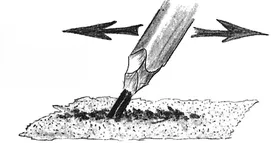
Figure 1-2
Using sandpaper to properly point up the pencil.
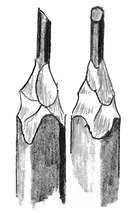
Figure 1-3
Properly sharpened pencils.

Figure 1-4
Pencil eraser.
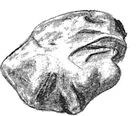
Figure 1-5
Kneaded eraser.
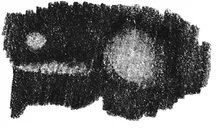
Figure 1-6
Pressing kneaded eraser on drawing produces lightened areas.
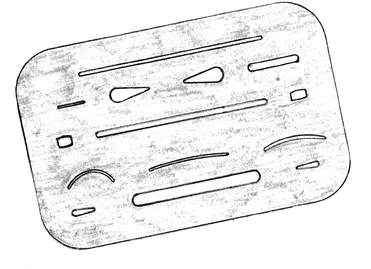
Figure 1-7
Erasing shield.

Figure 1-8
Using eraser shield and pencil eraser makes sharp lines.
Erasing Shield
An erasing shield is a very handy drafting tool (fig. 1-7). It is a thin piece of stainless steel with variously shaped cutouts. You lay it on your drawing to protect areas you do not want to touch, and to expose what you want to erase. You then use the pencil eraser to trim an edge or to erase in the middle of a toned area, as illustrated in figure 1-8.
Paper Towel
I use a folded paper towel like a paint brush to dust the eraser residue from my drawing.
Fixative
I use clear spray enamel to fix or protect my finished drawings after I have cleaned up any smudges. Three or four light coats leaves an invisible, clean surface that greatly reduces smudging from handling or storage.
Two other pencil-like tools illustrated later are the lithographic crayon and the charcoal pencil. Both of these produce intense darks. The lithographic crayon leaves a waxy black residue that smears rather easily but works well with pen and ink. It is usually used on a highly textured paper such as coquille paper to produce a dotted gray background or shading tone very quickly. I use four or five layers of clear spray enamel over the drawings made with lithographic crayon. The use of this crayon with pen and ink is demonstrated in the section on sketching songbirds.
The charcoal pencil in the 4B or 6B grade also produces an intense black quickly. The dust residue may be blown off the drawing and details put in with pen. Charcoal pencil is suitable only on a coarser, toothy paper with grain enough to “hold” the charcoal. It, too, requires three or four coats of the fixative to keep it from rubbing off or smudging other areas.
Pen Drawing
The tools required for drawing with pen are widely available and vary in cost. What you spend depends entirely on your personal preferences. I use all three pens described below in my classes....